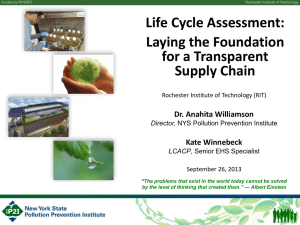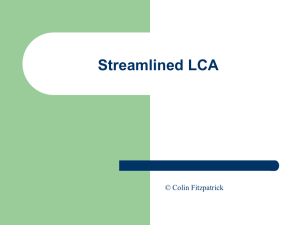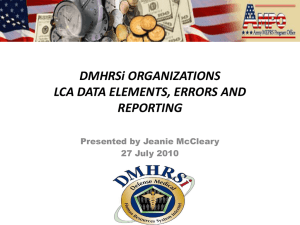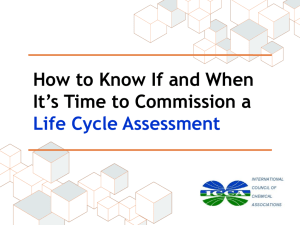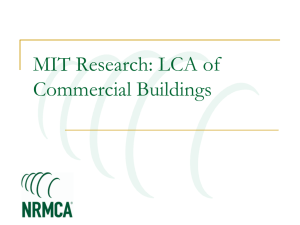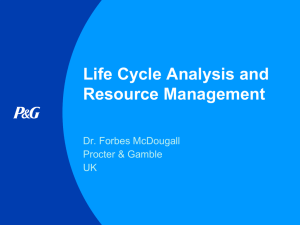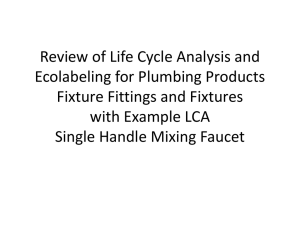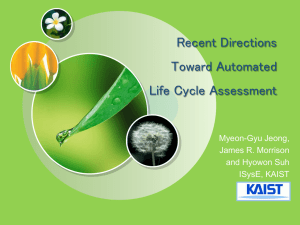Life Cycle Assessment (LCA)
advertisement
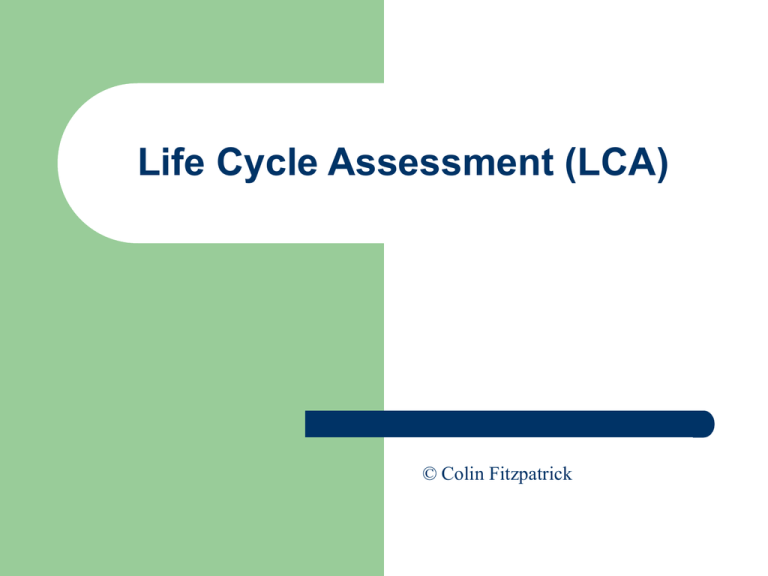
Life Cycle Assessment (LCA) © Colin Fitzpatrick Life Cycle Assessment (LCA) As corporations seek to improve their environmental performance they require new methods and tools. LCA is one such tool that can help companies to understand the environmental impacts associated with their products, processes and activities. LCA is controversial and still evolving as a methodology but the principles behind it are being adopted rapidly by organisations as a way of opening new perspectives and expanding the debate over environmentally sound products and processes. The goal of LCA is not to arrive at “the answer” but rather to provide important inputs to a broader strategic planning process Life Cycle Assessment (LCA) Defined in Industrial Ecology as – The life cycle assessment is an objective process to evaluate the environmental burdens associated with a product, process or activity by identifying, quantifying and assessing the impact of energy and material usage and environmental releases and to implement opportunities to effect environmental considerations. Life Cycle Assessment (LCA) Life Cycle Assessment is an environmental management tool. The International Organisation for Standardisation (ISO) defines LCA as – A compilation and evaluation of the inputs, outputs and potential environmental impacts of a product throughout its lifecycle Full Life Cycle Assessment (LCA) Primary Resources Extraction & Processing Production Use Reuse/ Recycle Disposal Emissions & Waste Life Cycle Assessment (LCA) The LCA methodology is standardised by a series of ISO standards and includes the following phases – – – – 1. Goal and scope definition (ISO 14041) 2. Inventory Analysis (ISO 14041) 3. Impact Assessment (ISO 14042) 4. Interpretation (ISO 14043) Goal and Scope Definition The first phase of LCA includes definition of – – – – The purpose of the study and its intended use The system and system boundaries The functional unit Data quality, the assumptions and limitations of the study Goal and Scope Definition Purpose of the LCA – – Internal External Goal and Scope Definition System Boundaries – – Depends on scope of LCA Depends on type of product and suitability for full LCA Goal and Scope Definition Functional Unit – – – Quantitative measure Crucial for comparative LCA’s Beverage Example Goal and Scope Definition This phase also includes an assessment of the data quality and establishing the specific data quality goals. “Goal and Scope Definition” are constantly reviewed and refined during the process of carrying out an LCA as additional data becomes available. Inventory Analysis The purpose of the “Inventory Analysis” is to identify and quantify the environmental burdens in the life cycle of the activity under study. The burdens are defined by material and energy used in the system and emissions to air, liquid effluents and solid wastes discharged into the environment. Inventory Analysis includes the following steps – – – Detailed definition of the system under study Data collection Quantification of the burdens Inventory Analysis A system is defined as a collection of materially and energetically connected operations which performs some defined function. The system is separated from the environment by a system boundary Life Cycle Inventory Analysis Inputs Materials Energy Materials Acquisition Formulation, processing and Manufacturing Product Distribution Outputs Principal Products Coproducts Water effluents Water Product use Airborne emissions Air Recycle, products, components, materials Solid Waste Waste Management Other Environmental interactions Life Cycle Inventory Analysis Detailed system characterisation involves its disaggregation into a number of interlinked subsystems. Depending on the data available, the subsystems can represent the unit operations or a group of units. Life Cycle Inventory Analysis Environment System Functional Outputs Inputs Emissions/ Wastes Subsystems Life Cycle Inventory Analysis Environmental burdens are then quantified for each subsystem according to the formula i B j bc j ,i xi i 1 – Where bcj,i is burden j from activity i and xi is a mass or energy flow associated with that activity Calculating Environmental Burdens & Impacts in LCA - Example The system in this example has one functional output and each activity i from extraction of raw materials to final disposal generates a certain amount of CO2 and CH4. x2 x1 Extraction Production x3 Use Disposal FU CO2 = 0.2 kg/t CH4 = 0.1 kg/t x1 = 2t/tFU CO2 = 0.3 kg/t CH4 = 0.1 kg/t x2 = 1.5t/tFU CO2 = 0.1kg/t CH4 = 0.1kg/t x3 = 1t/tFU CO2 = 0.1kg/t CH4 = 0.3kg/t x4 = 0.5 t/tFU x4 Calculating Environmental Burdens & Impacts in LCA - Example Using the Environmental Burdens equation the total environmental burdens per functional unit related to the emissions of CO2 and CH4 are therefore BCO2 = ∑bcCO2 . xi = (0.2)2+(0.3)1.5+(0.1)1+(0.1)0.5 →BCO2 = 1.0 kg/tFU BCH4 = ∑bcCH4 . xi = (0.1)2+(0.1)1.5+(0.1)1+(0.3)0.5 →BCH4 = 0.6 kg/tFU Impact Assessment The environmental burdens quantified in “Inventory Analysis” are translated into the related environmental impacts. This is carried out within the following steps – – – – Classification Characterisation Normalisation Valuation Impact Assessment Classification – Involves the aggregation of environmental burdens into a smaller number of environmental impact categories to indicate their potential impacts on human and ecological health and the extent of resource depletion. The aggregation is done on the basis of the potential impacts of the burdens so that one burden can be associated with a number of impacts; eg Volatile Organic Compounds (VOC’s) contribute to both global warming and ozone depletion. The approach used most widely for classification of the impacts is known as ‘problem oriented’, whereby the burdens are aggregated according to their relative contributions to the environmental effects they may have Impact Assessment The impacts most commonly considered in LCA are – – – – – – – – Non-renewable resource depletion Global warming Ozone depletion Acidification Eutrophication Photochemical oxidant formation Human toxicity Aquatic toxicity Impact Assessment Characterisation – Involves the quantification of the impact of interest relative to a reference substance. In the example we examined we look at the Global Warming Potential of the Products life cycle relative to CO2 emissions. Takes place using the formula j E k eck , j B j j 1 eck,j represents the relative contribution of burden Bj to impact Ek Classification Factors for Selected Burdens Calculating Environmental Burdens & Impacts in LCA - Example EGWP = (ecCO2)BCO2 + (ecCH4)BCH2 = 1(1) + 21(0.6) → EGWP = 13.6 kg CO2 equiv / tFU Impact Assessment Normalisation – The impacts can be normalised with respect to the total emissions or extractions in a certain area over a given period of time. This can help to asses the extent to which an activity contributes to the regional or global environmental impacts. Should be interpreted with care due to lack of reliable data. Impact Assessment Valuation – Each impact is assigned a weight which indicates its relative importance. As a result the environmental impacts are aggregated into a single environmental impact function EI k EI wk E k 1 Where wk is the relative importance of impact Ek Impact Assessment Valuation – – A number of problems at philosophical and practical level in the realisation of this and there is no consensus on the best way to aggregate the environmental impacts into a single EI figure. Some people argue that valuation should not be carried out at all as it obscures information and that considering the impact in a disaggregated form enhances the transparency of the decision making based on LCA results Interpretation This phase is aimed at system improvements and innovation and it includes the following steps – – – – Identification of major burdens and impacts Identification of ‘hot spots’ in the life cycle Sensitivity analysis Evaluation of findings and recommendations Interpretation Sensitivity Analysis – Indicates the level of reliability of the LCA Data availability and reliability Uncertainties Data gaps Further Reading Azapagic et al, Appendix Life Cycle Thinking & Life Cycle Assessment
